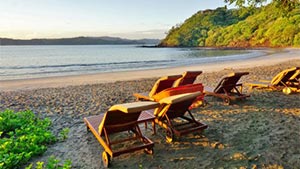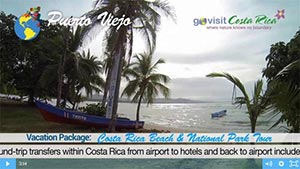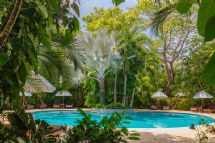The Guanacaste province is named for the Guanacaste tree, found in the entire region. This is the largest province in the country, bordered by two beautiful mountain ranges, with a coastline of rich, sandy beaches with stunning views. The area is home to one-third of the national parks and wildlife reserves in Costa Rica, making it an ecotourism playground with natural habitats, wildlife refuges and forests that are protected against development. It’s the ideal retreat for any vacationer who wants elegant and luxurious accommodations in eco friendly hotels.
Beaches, Forests and Volcanoes
If you love the sun and beach, you’ll want to make sure to plan your vacation during the dry season, but gorgeous beach sunsets can be found all year round. Snorkeling, fishing and kayaking are some of the activities at the eco hotels along the beach, but if you’re not into water sports, you may enjoy bird watching, horseback riding or turtle watching as part of your relaxation experience.
Playa Tamarindo is one of the beaches which calls to surfers, but there are many other things to do while you’re visiting this area. You might enjoy and zip line and canopy tour or a turtle nesting tour. In the winter season, from December to April, you can fish from shore. There are many eco hotels in Guanacaste where you can and find luxurious accommodations that will fit into your budget while providing a vacation experience like no other.
Guanacaste Conservation Area
Santa Rosa National Park protects the natural environment of the historical site of Santa Rosa. There are 10 natural habitats within the park, including deciduous forest, marshland, savanna and tropical rainforests. Several cat species reside in the park, as do 250 bird species, many types of turtles and amphibians. Coyotes, coatis, tapirs are just a few of the 115 mammal species which can be found.
Rincón de la Vieja National Park is home to two active volcanoes and a dormant one. The last eruption was in July 2017. As with much of Costa Rica, the park is a natural habitat for a large variety of wildlife, including eagles, cougars, kinkajous and over 300 species of birds. In Guanacaste, the only ecosystem not represented is a desert. UNESCO recognizes the importance of this area by admitting the Guanacaste Conservation Center as a World Heritage Site. Many endangered or rare plants and animals can be found in this sector.
Map of Guanacaste

At Lomas de Barbudal Biological Reserve, you can find almost a quarter of the world’s bees species. It’s a tropical dry forest ecosystem that is a stronghold for scarlet macaws, giant anteaters and colored peccaries, but there are many other species that call this area home. If you come during the wet season, the insects may overwhelm you, but it’s a still a beautiful time to visit. The best time to visit is when the corteza amarilla trees blossom from mid-March to mid-April. It’s called a botanical fireworks, because when these trees bloom, the other trees in forest seem to realize it’s time to come to life.
The Best Weather
Although there is a wet season, Guanacaste province is usually warmer than other places in the country and there is little rain from November to April. The temperatures are consistent and comfortable in the dry season. December through April are the peak seasons for Guanacaste eco hotels. If you’re planning your vacation around a major holiday, like Christmas or Easter, you’ll want to make early reservations to ensure you have a relaxing trip. Guanacaste is a beautiful place to visit if you enjoy nature and spectacular landscapes. With more than 200 miles of coastline and 1470 square kilometers of natural preserves, there’s a lot to see and do.
7 Days / 6 Nights
Starting at $978 per person
14 Days / 13 Nights
Starting at $2,098 per person









.jpg)



.jpg)

